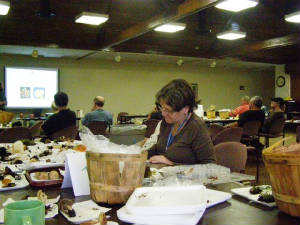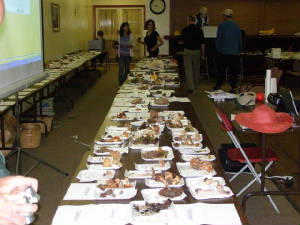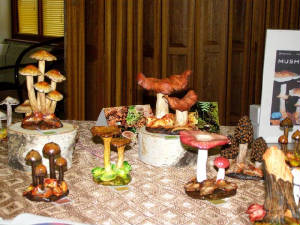|
The fourth foray took place at the Debert hospitality centre in Debert near Truro,Nova Scotia. The organisers did their
best to organise the weather but unfortunately it did not co-operate. We had rain almost constantly over the three day event.
Never the less, enough brave and waterproof people showed up to make it another resounding success.
On hand to guide us through the process were some wonderful,entertaining and very knowledgeable people.
Amongst them were;
Dr David Boyle,of the Nova Scotia Agricultural College in Truro. Dr Greg Thorne,associate professor of the University
of Western Ontario. Renee LeBouef of the Cercle des mycologues de Montreal. Dr Gavin Kernaghan,professor at Mt St Vincent
University in Halifax.Dr Scott Cunningham who has a doctorate in molecular biology.Nelson Poirier who is a veterinarian by
traing and also an avid amateur mycologist.Last but certainly not least is Catherine Pross an accomplished amateur
mycologist and photographer who has been the official photographer of the Mycological Society since the founding of the society
four years ago.
This year there were four trails to pick from with varying habitats and degrees of difficulty in regard to the topography,they
were;
1. Gully lake,which was of a moderate physical challenge. Led by Dr Gavin Kernaghan.
2. Horse Pastures consisting mostly of white spruce and hardwood. This was of an easy to moderately demanding trail and
was led by Dr Greg Thorne.
3. Mi'kma'ki trail which was the least physically demanding of the four trails. It also had the added attraction of coming
under the Nova Scotia Special Places Protection Act and it is also recognised as a National Historic site for it's archaelogical
significance.There are interpretive boards as you make your way around the trail,some 4.4km in length. The trail was
also of interest because of it's sand plains,white spruce and red pine. This trail was led by Renee LeBouef.
4. The fourth trail was Staples Brook which by all accounts was very physically demanding. It consisted mostly of red spruce
and is a candidate for a new wilderness area.This trail was led by Bruce Stewart,Nelson Poirier and Scott Cunningham.
I chose to explore the Mi'kma'ki trail and as you can see from the three photographs above the weather was no impediment
to the young man on the crutches! We mushroom people are a breed apart and he managed the trail quite well in spite of his
temporary handicap.

Pictured at left is Renee Lebouef who I assisted in the identification process that we did after arriving back from the
Mi'kma'ki trail some five hours after departing.
We were all tired and a little wet but the rain did nothing to dampen our spirits.

Each trail was identified by a different number,one through four. All the mushrooms collected from each trail were placed
on the corresponding table. Pictured on the right are all the mushrooms that we collected from each trail
and had up to that point identified.

In addition to the "real thing" we also had a lady showing some of her sculptures. Everyone was impressed with the attention
to detail that was so clearly evident.
On Sunday there were several workshops offered that varied greatly in their content but had an overall mushroom theme,they
were;
- Growing mushrooms at home.
- Cooking with mushrooms.
- "Pick for the Pot", a.k.a. back in to the woods to find edible mushrooms.
- Mushrooms as fabric dye.
- Trees,lichens and mushrooms and what do they have to do with mushrooms?
- Photographing Nature.
Each workshop lasting for about three hours.
I elected to attend the workshop on growing mushrooms at home since I have been tinkering with the idea for quite some
time. There were two methods outlined on how to grow mushrooms at home. One was in plastic bags with the substrate being bird
seed. The other was to drill and inoculate sawn logs with spawn,seal with wax and let nature take it's course,all the
while keeping the logs moist. The photographs below show the instructors passing on their knowledge and expertise.
During the workshop I met some interesting people and one of them shows off her new haircut.
By three o'clock on Sunday afternoon with mushroom identification still in progress we had managed to identify 148
species. It was estimated that the grand total would approach 200. As in the last three years the mushrooms will find
a home in the Harriet Irving herbarium at Acadia University in Wolfville,Nova Scotia.
|




